Experimental Investigation on Ambient-Cured One-Part Alkali-Activated Binders Using Combined High-Calcium Fly Ash (HCFA) and Ground Granulated Blast Furnace Slag (GGBS)
Abstract
:1. Introduction
2. Experimental Programme
2.1. Materials
2.1.1. High-Calcium Fly Ash (HCFA)
2.1.2. Ground Granulated Blast Furnace Slag (GGBS)
2.1.3. Solid Activator
2.2. Design Mix Proportions
- Series A: This test series was the first series conducted to define the appropriate binder proportion between HCFA and GGBS. The GGBS/binder ratio was taken as the main parameter in this investigation. The activator/binder and water/binder ratios were kept constant in this series at 0.12 and 0.40, respectively. A total of 8 mixes with various proportions between HCFA and GGBS were conducted.
- Series B: This test series was intended to evaluate the effect of the activator/binder ratio on the one-part alkali-activated paste. After the evaluation of Series A, the optimum GGBS/binder ratio will be used in this series. Additionally, the water/binder ratio was kept constant at 0.40. In total, there are 6 mixes in this series.
- Series C: In this final test series, the main variable will be the water/binder ratio. In total, there are 4 mixes in this series. The GGBS/binder ratio and activator/binder ratio used are based on the results obtained from Series A and B, respectively.
2.3. Mixing, Casting and Curing
2.4. Test Methods
3. Results and Discussion
3.1. Test Series A: Proportion of HCFA and GGBS
3.1.1. Fresh Paste Properties
3.1.2. Density
3.1.3. Compressive Strength
3.1.4. Discussion of Results from Test Series A
3.2. Test Series B: Activator to Binder Ratio
3.2.1. Fresh Paste Properties
3.2.2. Density
3.2.3. Compressive Strength
3.2.4. Discussion of Results from Test Series B
3.3. Test Series C: Water to Binder Ratio
3.3.1. Fresh Paste Properties
3.3.2. Density
3.3.3. Compressive Strength
3.3.4. Discussion of Results from Test Series C
4. Conclusions
- There was a definite limit on the SiO2 content in contributing to compressive strength. Based on our test results, the maximum compressive strength was achieved at the SiO2/Al2O3 molar ratio somewhere between 3.20 and 3.30. Once it passed the limit, the compressive strength decreased.
- The addition of GGBS with HCFA improved the reactivity of the precursor materials. It enhanced the flowability and compressive strength development in the ambient-cured condition. The optimum GGBS/binder ratio was found at 0.50. It was deduced based on flowability and compressive strength test results from mixture A6, where it achieved a compressive strength of 80 MPa at 28 days with a flow spread diameter of 214.75 mm (114.8% flow).
- The optimum activator/binder ratio was found in the range between 0.08 and 0.12, which satisfied both the flowability performance (>100% flow) and the attainment of compressive strength up to 80 MPa. There was a limit on the effective amounts of solid activators in the contribution to the alkali-activation reaction process, which was greatly influenced by the SiO2 content or the SiO2/Al2O3 molar ratio.
- Increased water content would increase the flowability, but it reduced the compressive strength and density. Low water/binder ratios should be considered in all cases as this greatly affects the dissolution and participation of SiO2 in stages of gel formation. It is recommended that the water/binder ratio should not exceed 0.50.
Author Contributions
Funding
Institutional Review Board Statement
Informed Consent Statement
Data Availability Statement
Acknowledgments
Conflicts of Interest
References
- Ali, M.B.; Saidur, R.; Hossain, M.S. A review on emission analysis in cement industries. Renew. Sustain. Energy Rev. 2011, 15, 2252–2261. [Google Scholar] [CrossRef]
- Hardjito, D.; Wallah, S.E.; Sumajouw, D.M.J.; Rangan, B.V. On the development of fly ash-based geopolymer concrete. ACI Mater. J. 2004, 101, 467–472. [Google Scholar]
- Hardjito, D.; Rangan, B.V. Development and Properties of Low-Calcium Fly Ash-Based Geopolymer Concrete; Research Report GC-1; Curtin University of Technology: Perth, Australia, 2005; 103p. [Google Scholar]
- Chithambaram, S.J.; Kumar, S.; Prasad, M.M.; Adak, D. Effect of parameters on the compressive strength of fly ash based geopolymer concrete. Struct. Concr. 2018, 19, 1202–1209. [Google Scholar] [CrossRef]
- Nath, P.; Sarker, P.K. Effect of GGBFS on setting, workability and early strength properties of fly ash geopolymer concrete cured in ambient condition. Constr. Build. Mater. 2014, 66, 163–171. [Google Scholar] [CrossRef] [Green Version]
- Kaur, K.; Singh, J.; Kaur, M. Compressive strength of rice husk ash based geopolymer: The effect of alkaline activator. Constr. Build. Mater. 2018, 169, 188–192. [Google Scholar] [CrossRef]
- Nadziri, N.; Ismail, I.; Hamdan, S. Binding gel characterization of alkali-activated binders based on palm oil fuel ash (POFA) and fly ash. J. Sustain. Cem.-Based Mater. 2018, 7, 1–14. [Google Scholar] [CrossRef]
- Provis, J.L. Alkali-activated materials. Cem. Concr. Res. 2018, 114, 40–48. [Google Scholar] [CrossRef]
- Shi, C.; Jimenez, A.F.; Palomo, A. New cements for the 21st century: The pursuit of an alternative to Portland cement. Cem. Concr. Res. 2011, 41, 750–763. [Google Scholar] [CrossRef]
- Duxson, P.; Provis, J.L.; Lukey, G.C.; van Deventer, J.S.J. The role of inorganic polymer technology in the development of green concrete. Cem. Concr. Res. 2007, 37, 1590–1597. [Google Scholar] [CrossRef]
- Duxson, P.; Fernandez-Jimenez, A.; Provis, J.L.; Palomo, A.; van Deventer, J.S.J. Geopolymer technology: The current state of the art. J. Mater. Sci. 2007, 42, 2917–2933. [Google Scholar] [CrossRef]
- Hassan, A.; Arif, M.; Shariq, M. Use of geopolymer concrete for a cleaner and sustainable environment—A review of mechanical properties and microstructure. J. Clean. Prod. 2019, 223, 704–728. [Google Scholar] [CrossRef]
- Singh, B.; Ishwarya, G.; Gupta, M.; Bhattacharyya, S.K. Geopolymer concrete: A review of some recent developments. Constr. Build. Mater. 2015, 85, 78–90. [Google Scholar] [CrossRef]
- Zakka, W.P.; Abdul Shukor Lim, N.H.; Chau Khun, M. A scientometric review of geopolymer concrete. J. Clean. Prod. 2021, 280, 124353. [Google Scholar] [CrossRef]
- Yang, K.-H.; Song, J.-K.; Ashour, A.F.; Lee, E.-T. Properties of cementless pastes activated by sodium silicate. Constr. Build. Mater. 2008, 22, 1981–1989. [Google Scholar] [CrossRef] [Green Version]
- Yang, K.-H.; Song, J.-K. Workability loss and compressive strength development of cementless pastes activated by combination of sodium silicate and sodium hydroxide. ASCE J. Mater. Civ. Eng. 2009, 21, 119–127. [Google Scholar] [CrossRef]
- Hajimohammadi, A.; Provis, J.L.; van Deventer, J.S.J. One-part geopolymer mixes from geothermal silica and sodium aluminate. Ind. Eng. Chem. Res. 2008, 47, 9396–9405. [Google Scholar] [CrossRef]
- Hajimohammadi, A.; van Deventer, J.S.J. Characterisation of one-part geopolymer binders made from fly ash. Waste Biomass Valorization 2017, 8, 225–233. [Google Scholar] [CrossRef]
- Choo, H.; Lim, S.; Lee, W.; Lee, C. Compressive strength of one-part alkali activated fly ash using red mud as alkali supplier. Constr. Build. Mater. 2016, 125, 21–28. [Google Scholar] [CrossRef]
- Kim, M.S.; Jun, Y.; Lee, C.; Oh, J.E. Use of CaO as an activator for producing a price-competitive non-cement structural binder using ground granulated blast furnace slag. Cem. Concr. Res. 2013, 54, 208–214. [Google Scholar] [CrossRef]
- Provis, J.L.; van Deventer, J.S.J. Alkali Activated Materials: State-of-the-Art Report, RILEM TC 224-AAM; Springer Science & Business Media: Cham, Switzerland, 2014; Volume 13, p. 388. [Google Scholar] [CrossRef]
- Nematollahi, B.; Sanjayan, J.; Ahmed Shaikh, F.U. Synthesis of heat and ambient cured one-part geopolymer mixes with different grades of sodium silicate. Ceram. Int. 2015, 41, 5696–5704. [Google Scholar] [CrossRef]
- Luukkonen, T.; Abdollahnejad, Z.; Yliniemi, J.; Kinnunen, P.; Illikainen, M. Comparison of alkali and silica sources in one-part alkali-activated blast furnace slag paste. J. Clean. Prod. 2018, 187, 171–179. [Google Scholar] [CrossRef]
- Ma, C.; Long, G.; Shi, Y.; Xie, Y. Preparation of cleaner one-part geopolymer by investigating different types of commercial sodium metasilicate in China. J. Clean. Prod. 2018, 201, 636–647. [Google Scholar] [CrossRef]
- Ma, C.; Zhao, B.; Guo, S.; Long, G.; Xie, Y. Properties and characterization of green one-part geopolymer activated by composite activators. J. Clean. Prod. 2019, 220, 188–199. [Google Scholar] [CrossRef]
- Askarian, M.; Tao, Z.; Samali, B.; Adam, G.; Shuaibu, R. Mix composition and characterisation of one-part geopolymers with different activators. Constr. Build. Mater. 2019, 225, 526–537. [Google Scholar] [CrossRef]
- Chindaprasirt, P.; De Silva, P.; Sagoe-Crentsil, K.; Hanjitsuwan, S. Effect of SiO2 and Al2O3 on the setting and hardening of high calcium fly ash-based geopolymer systems. J. Mater. Sci. 2012, 47, 4876–4883. [Google Scholar] [CrossRef]
- ASTM C618—12a; Standard Specification for Coal Fly Ash and Raw or Calcined Natural Pozzolan for Use in Concrete. ASTM International: West Conshohocken, PA, USA, 2012.
- BS EN 197-1; Cement—Part 1: Composition, Specifications and Conformity Criteria for Common Cements. BSI: London, UK, 2011.
- ASTM C230; Specification for Flow Table for Use in Tests of Hydraulic Cement. ASTM International: Philadelphia, PA, USA, 2014.
- Sasui, S.; Kim, G.; Nam, J.; Koyama, T.; Chansomsak, S. Strength and microstructure of class-c fly ash and ggbs blend geopolymer activated in NaOH & NaOH + Na2SiO3. Materials 2020, 13, 59. [Google Scholar] [CrossRef] [Green Version]
- Xie, J.; Wang, J.; Rao, R.; Wang, C.; Fang, C. Effects of combined usage of GGBS and fly ash on workability and mechanical properties of alkali activated geopolymer concrete with recycled aggregate. Compos. Part B 2018, 164, 179–190. [Google Scholar] [CrossRef]
- Luukkonen, T.; Abdollahnejad, Z.; Yliniemi, J.; Kinnunen, P.; Illikainen, M. One-part alkali-activated materials: A review. Cem. Concr. Res. 2018, 103, 21–34. [Google Scholar] [CrossRef]
- Ismail, I.; Bernal, S.A.; Provis, J.L.; Nicolas, R.S.; Hamdan, S.; van Deventer, J.S.J. Modification of phase evolution in alkali-activated blast furnace slag by the incorporation of fly ash. Cem. Concr. Compos. 2014, 45, 125–135. [Google Scholar] [CrossRef]
- Oderji, S.Y.; Chen, B.; Ahmad, M.R.; Ali Shah, S.F. Fresh and hardened properties of one-part fly ash-based geopolymer binders cured at room temperature: Effect of slag and alkali activators. J. Clean. Prod. 2019, 225, 1–10. [Google Scholar] [CrossRef]
- Khedmati, M.; Alanazi, H.; Kim, Y.-R.; Nsengiyumva, G.; Moussavi, S. Effects of Na2O/SiO2 molar ratio on properties of aggregate-paste interphase in fly ash-based geopolymer mixtures through multiscale measurements. Constr. Build. Mater. 2018, 191, 564–574. [Google Scholar] [CrossRef]
- Silva de Vargas, A.; Dal Molin, D.C.C.; Vilela, A.C.F.; José da Silva, F.; Pavão, B.; Veit, H. The effects of Na2O/SiO2 molar ratio, curing temperature and age on compressive strength, morphology and microstructure of alkali-activated fly ash-based geopolymers. Cem. Concr. Compos. 2011, 33, 653–660. [Google Scholar] [CrossRef]
- Bignozzi, M.C.; Manzi, S.; Natali, M.E.; Rickard, W.D.A.; van Riessen, A. Room temperature alkali activation of fly ash: The effect of Na2O/SiO2 ratio. Constr. Build. Mater. 2014, 69, 262–270. [Google Scholar] [CrossRef]

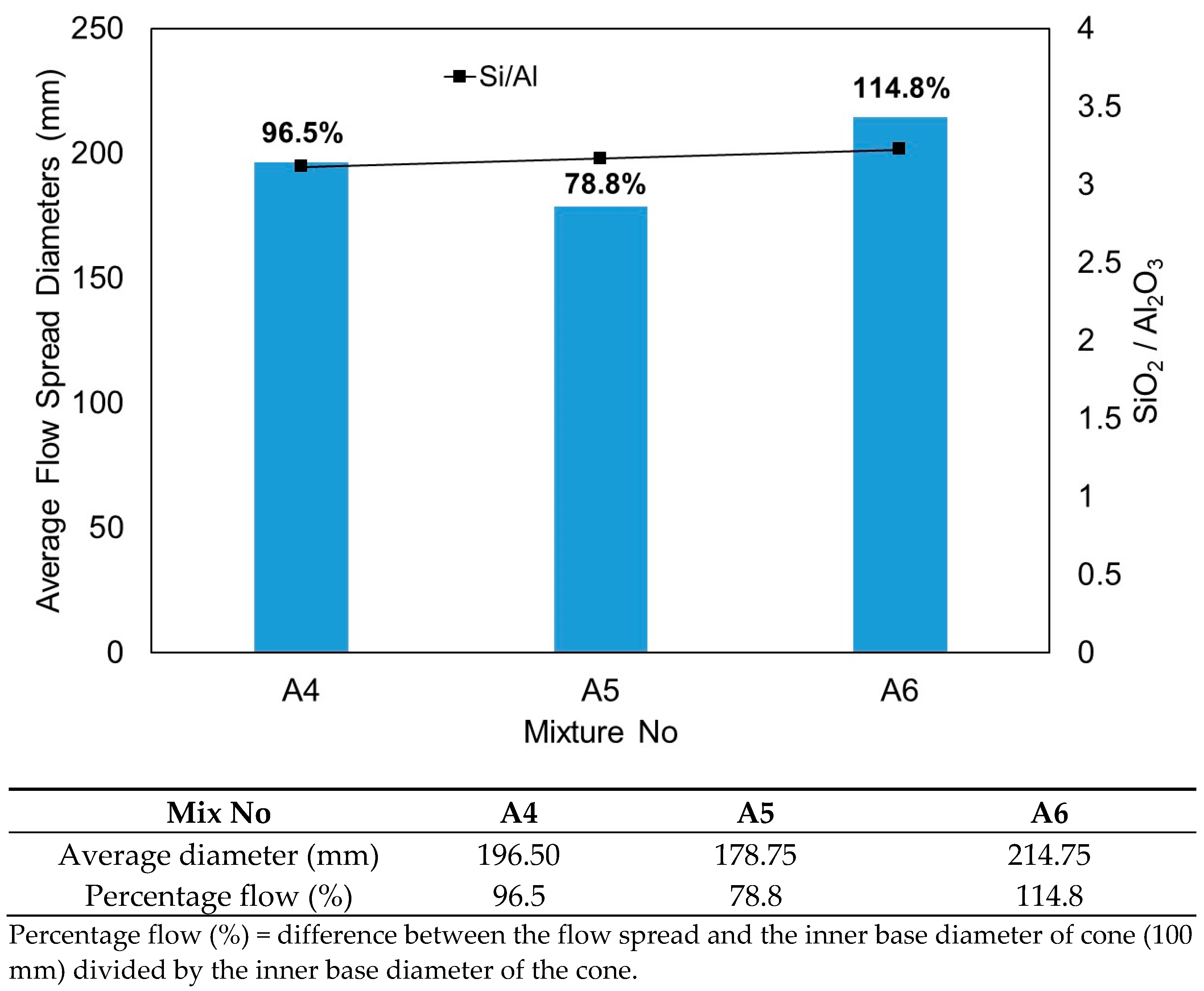
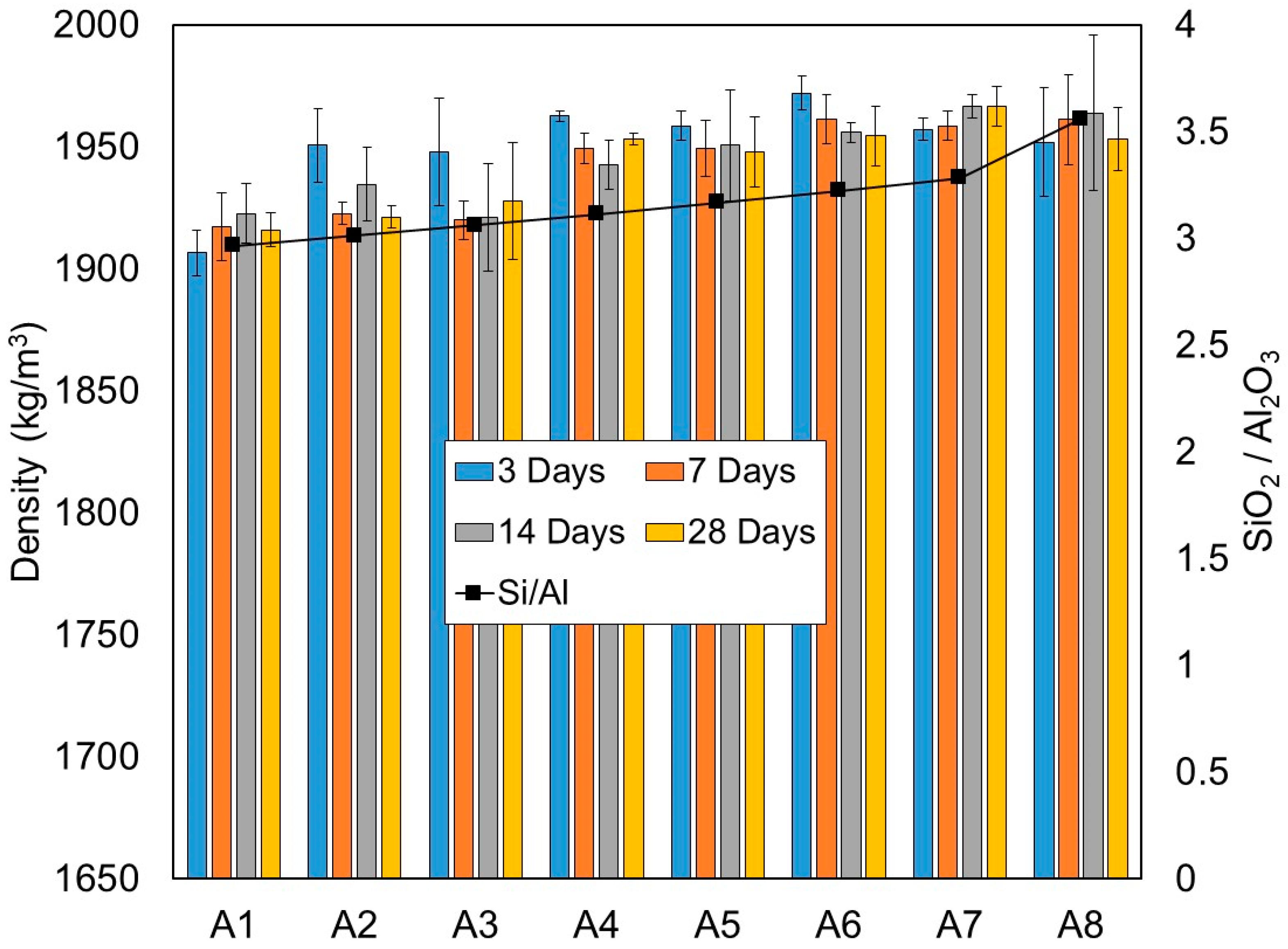
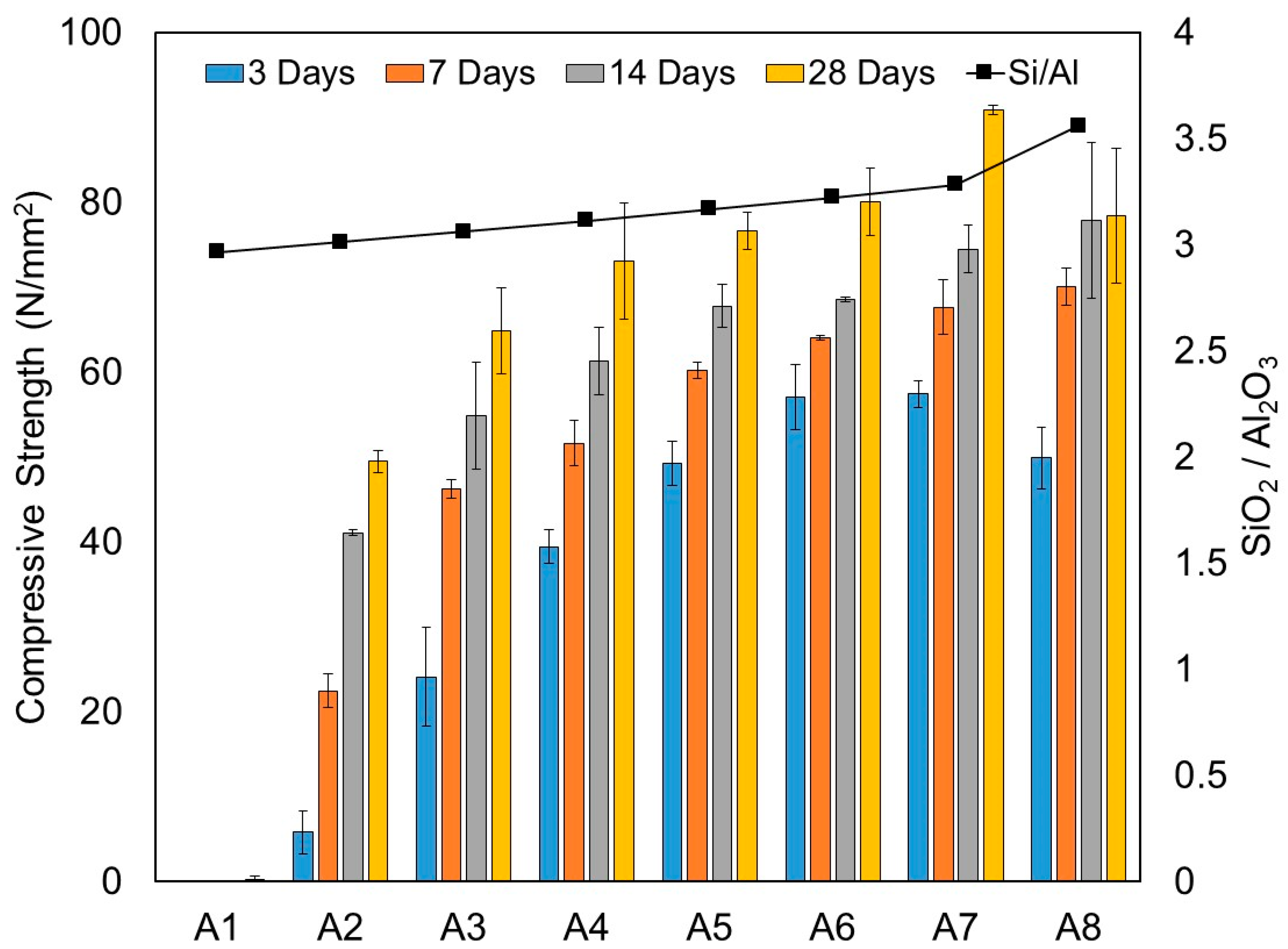
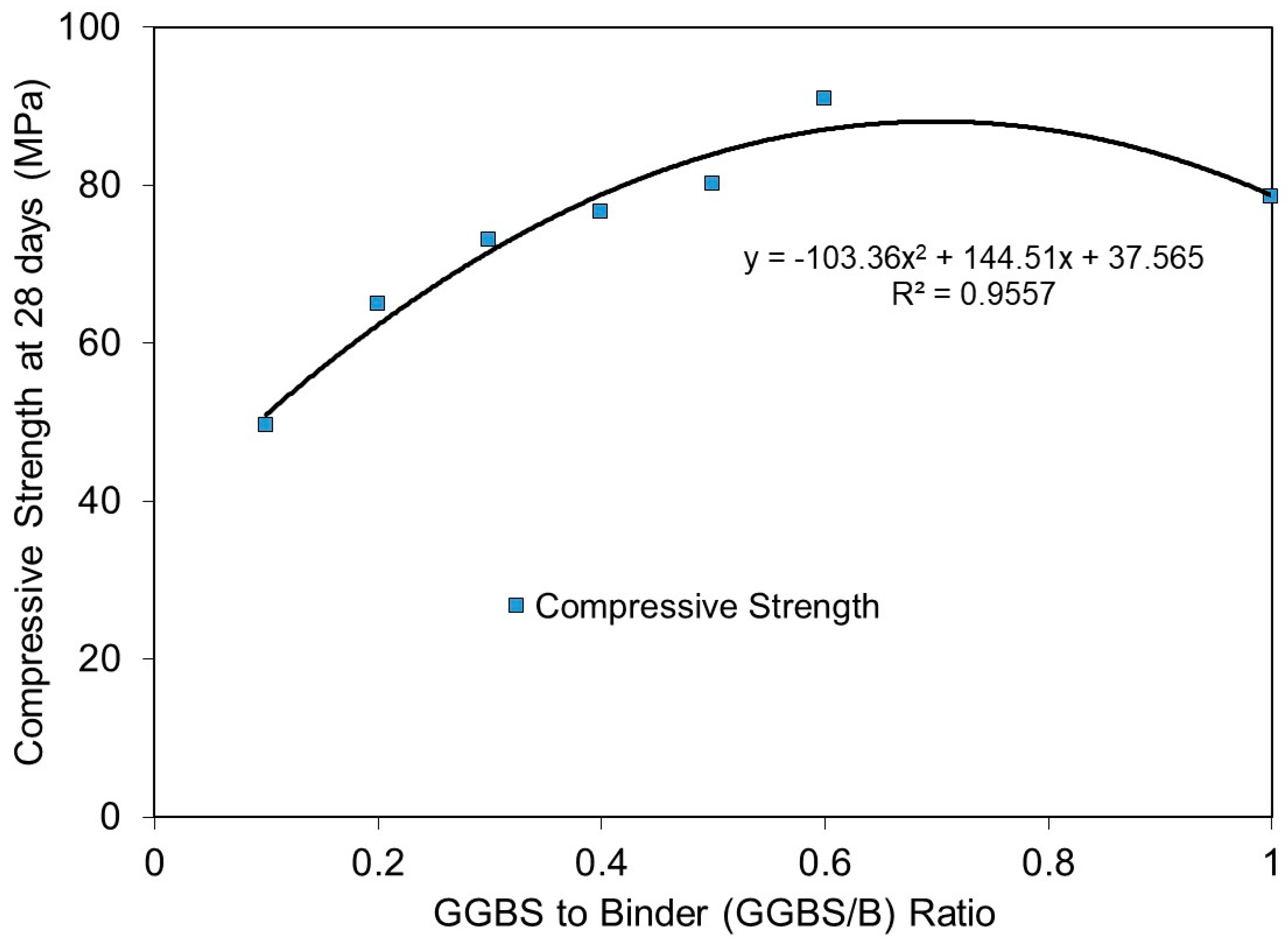
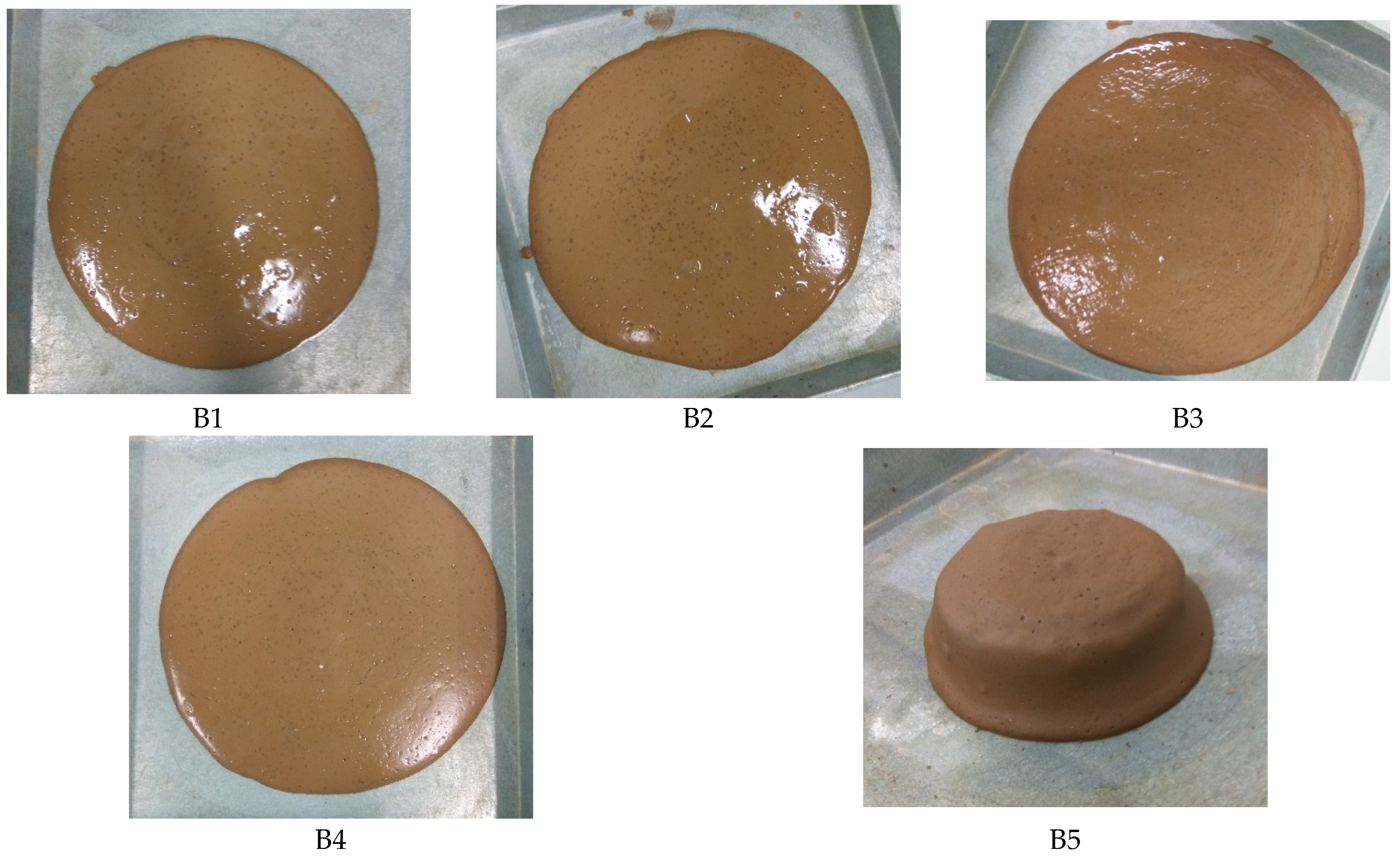
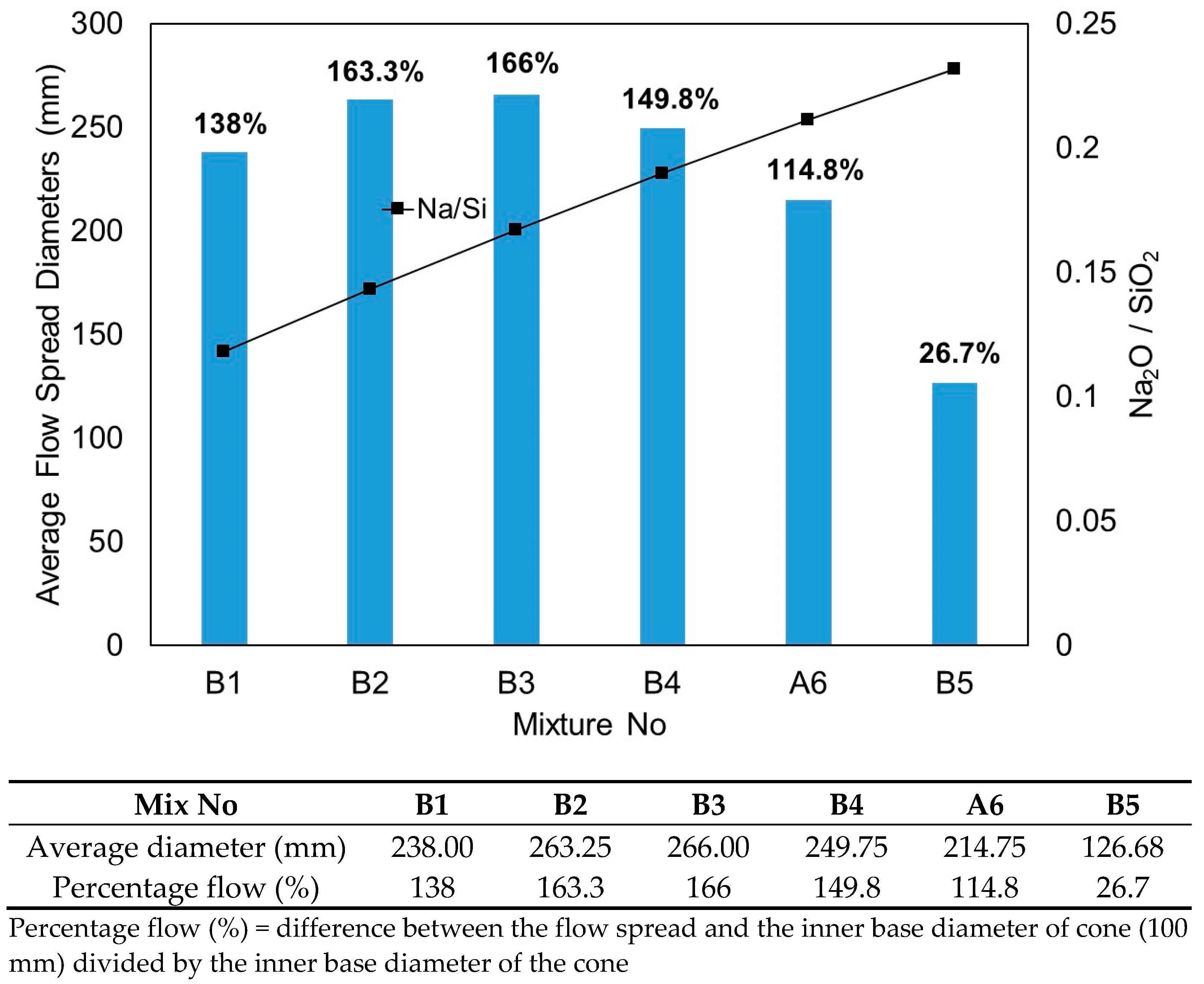
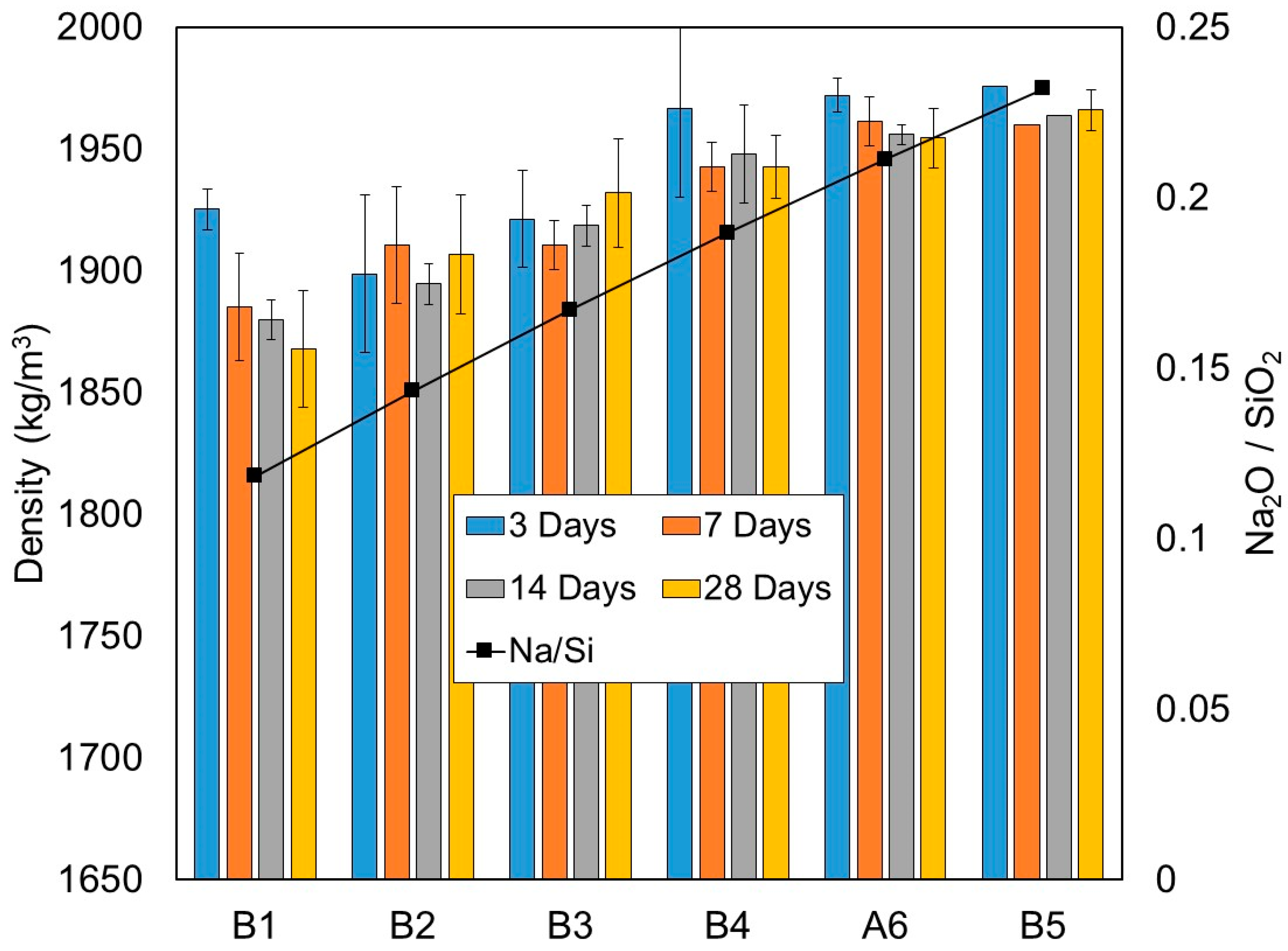
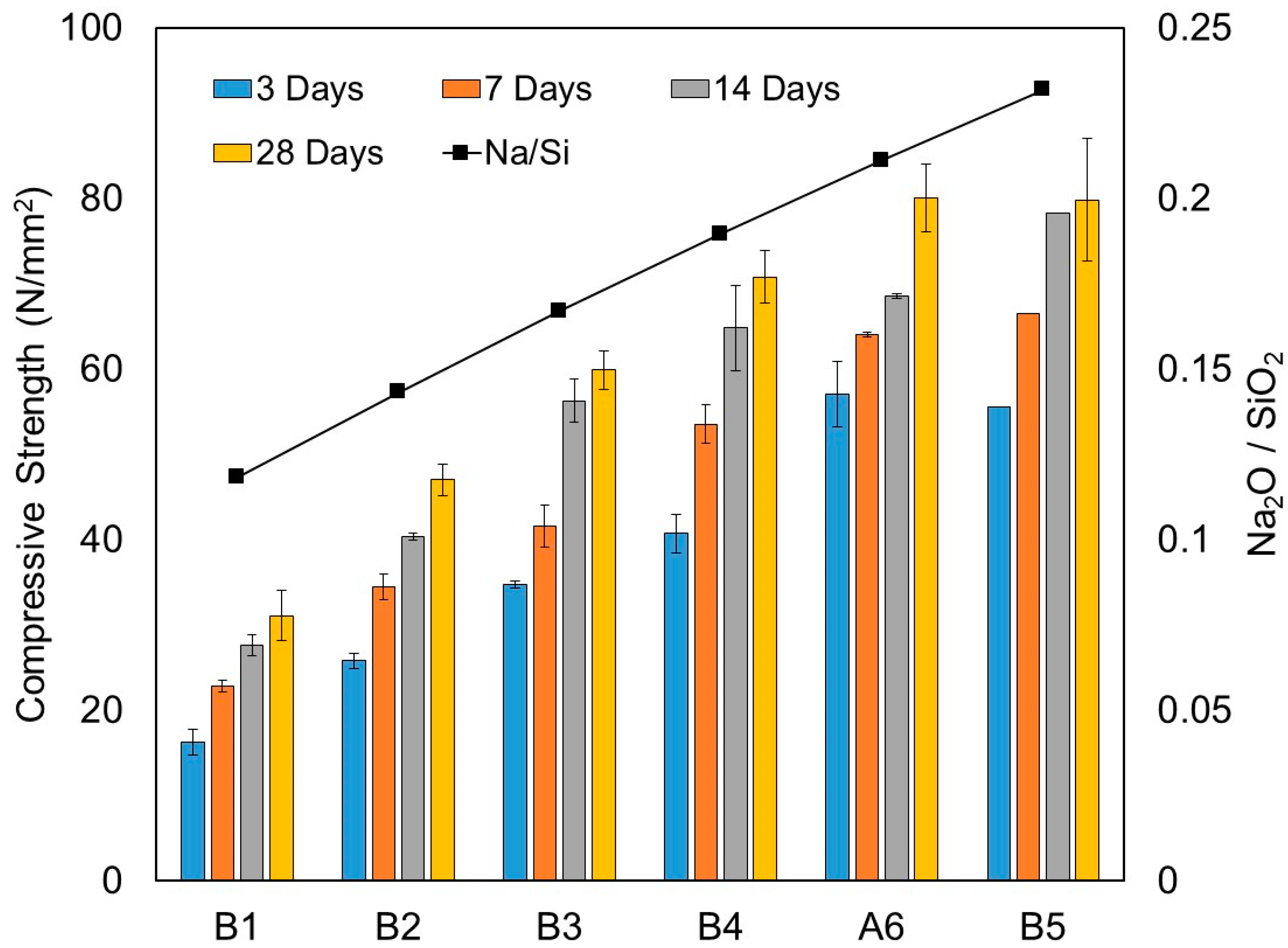
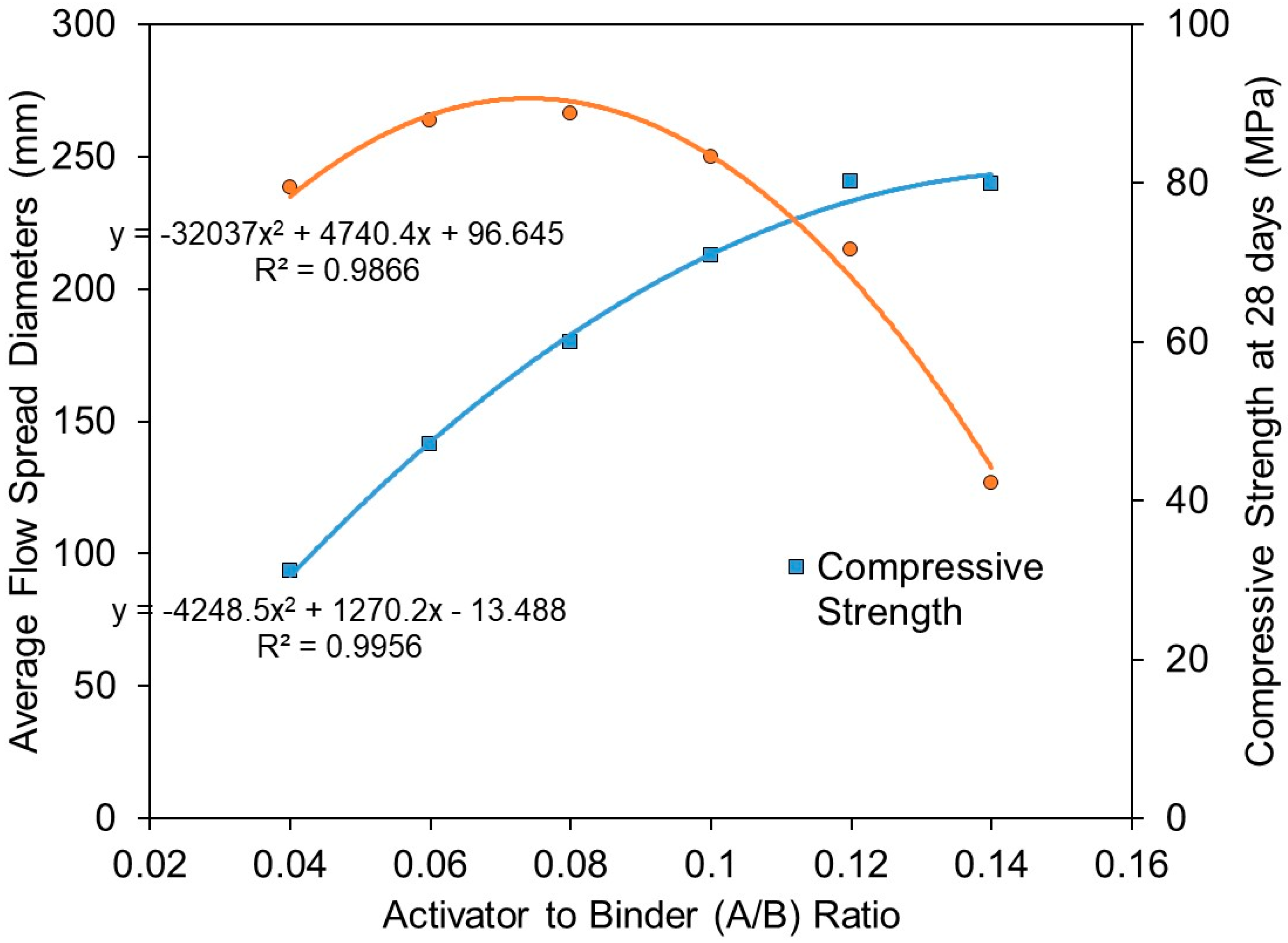
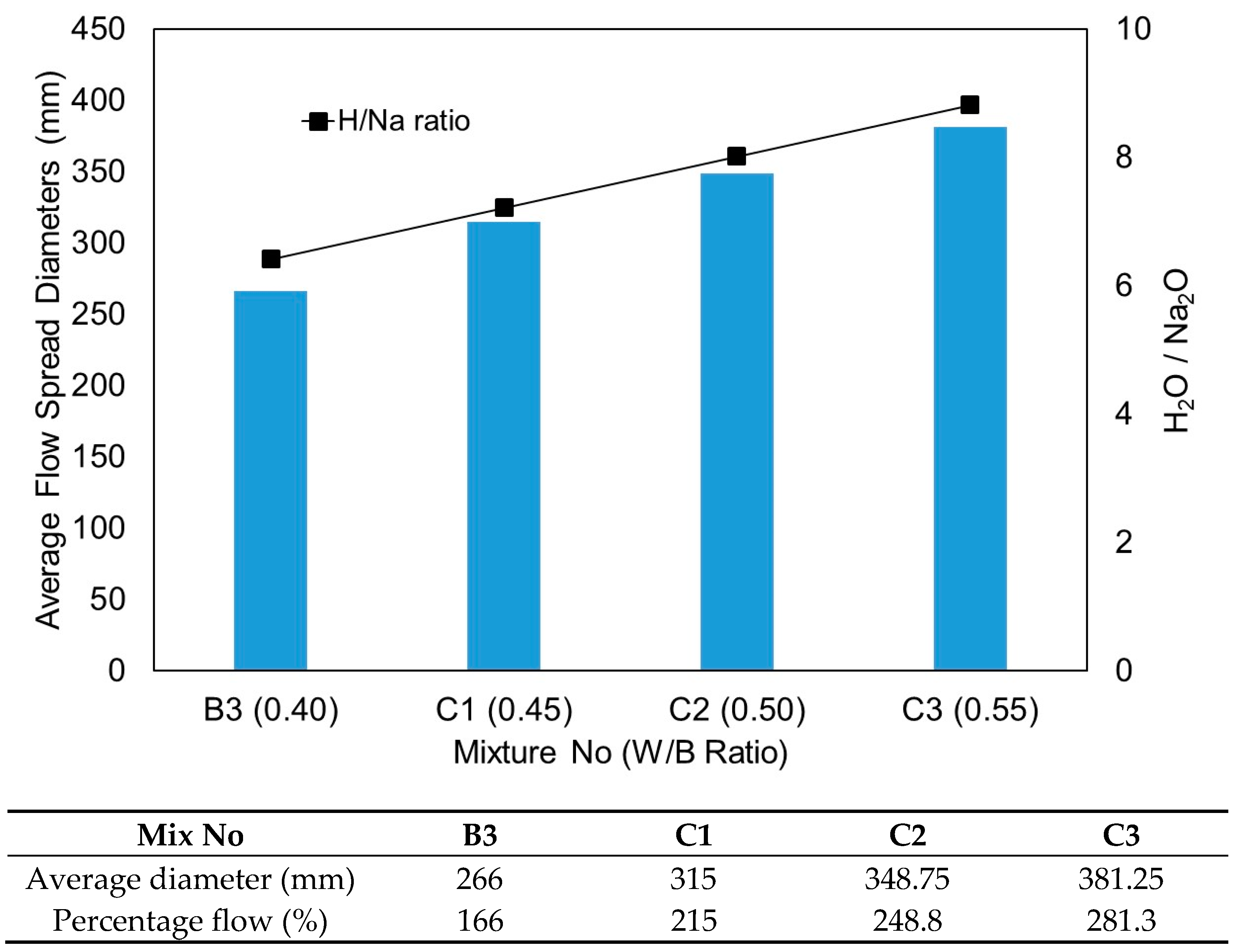

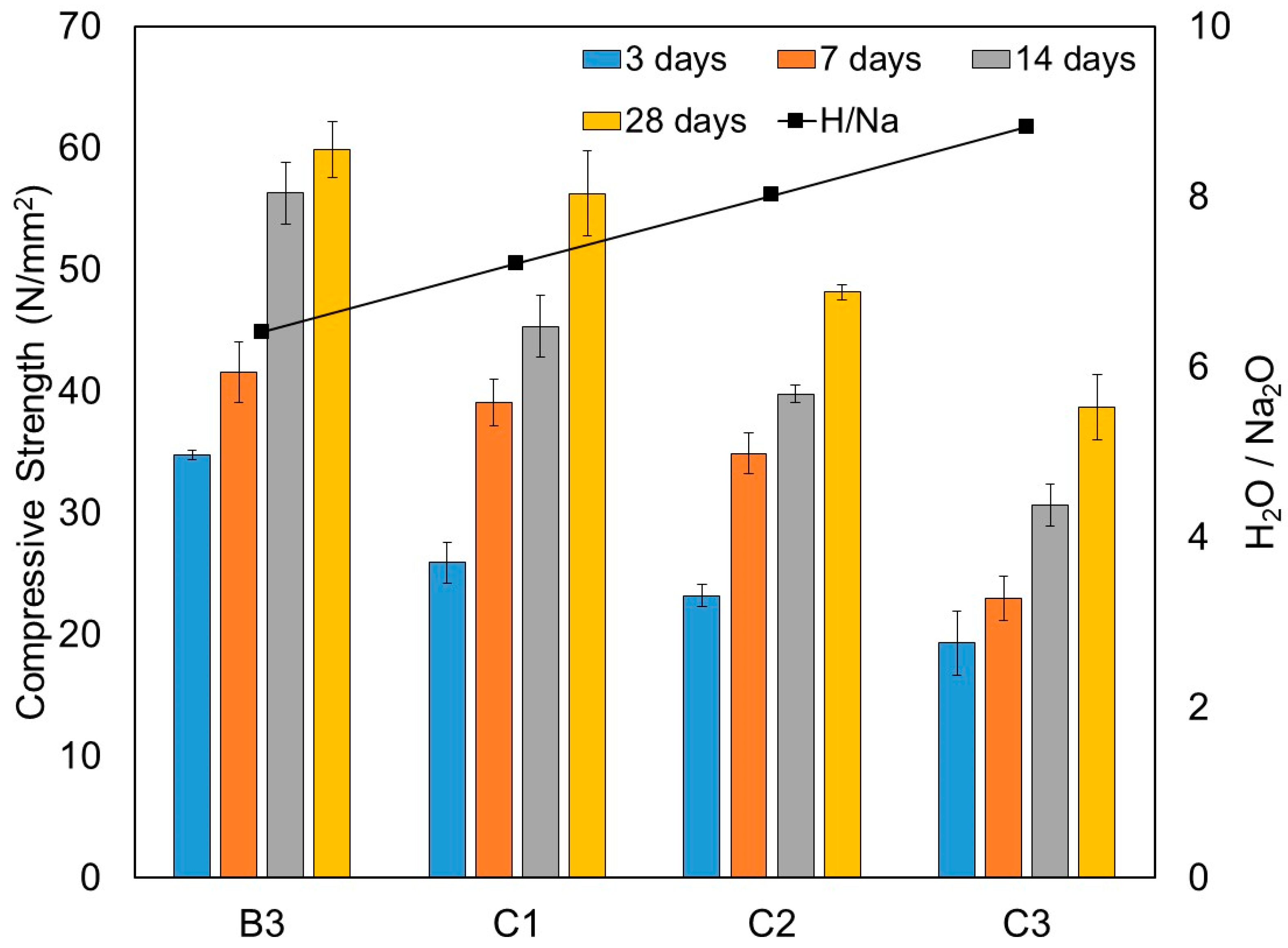
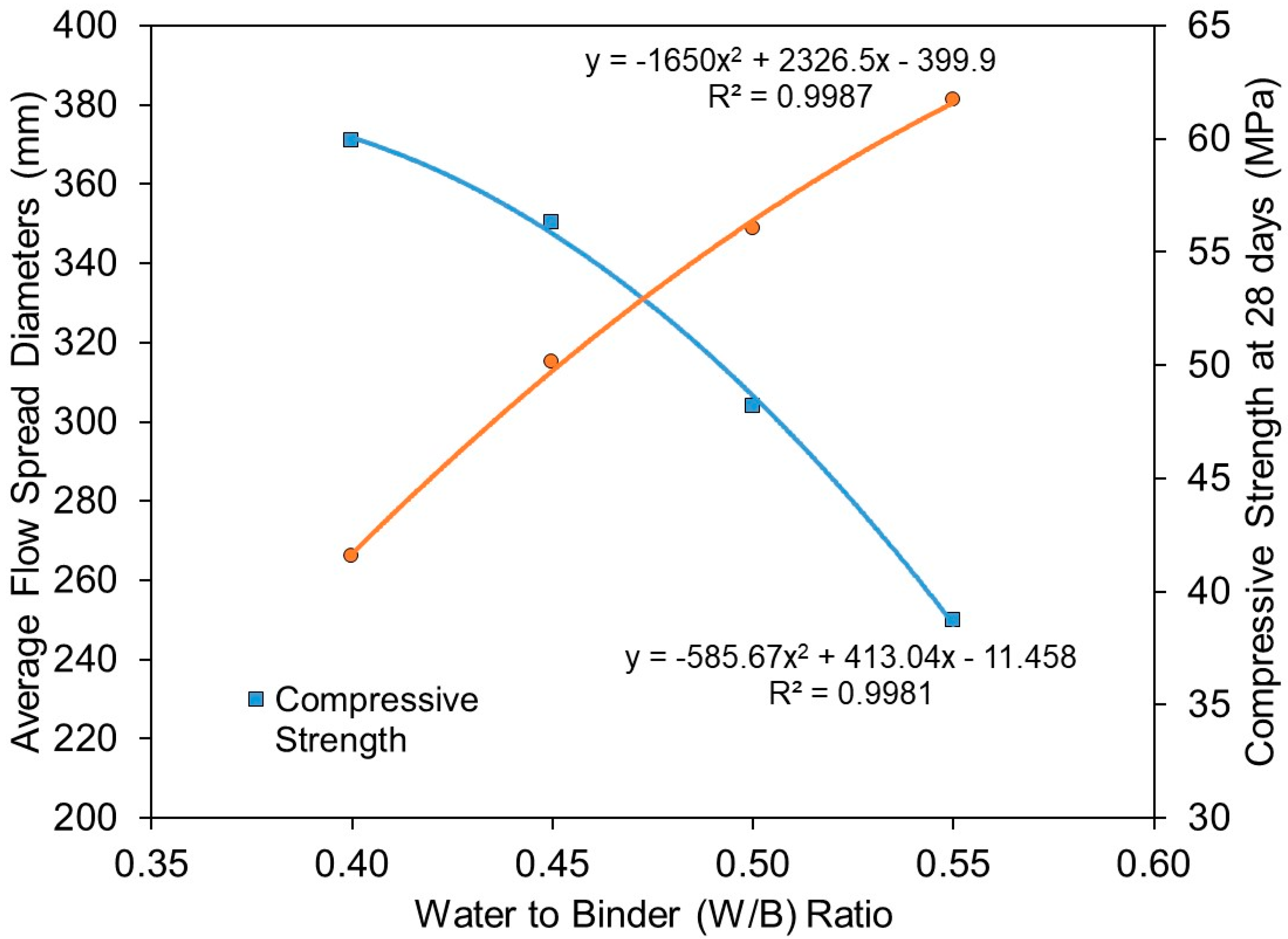
| Material | SiO2 | Al2O3 | Fe2O3 | CaO | MgO | Na2O | K2O | TiO2 | MnO |
|---|---|---|---|---|---|---|---|---|---|
| HCFA (%) | 35.07 | 13.71 | 13.12 | 18.94 | 8.66 | 4.02 | 1.18 | 0.79 | 0.14 |
| GGBS (%) | 32.15 | 10.60 | 0.39 | 43.46 | 6.58 | 0.28 | 0.36 | 0.65 | 0.24 |
| Mix No. | HCFA | GGBS | A/B | Activator | W/B | Water | Molarity | |||||
|---|---|---|---|---|---|---|---|---|---|---|---|---|
| % | kg/m3 | % | kg/m3 | kg/m3 | kg/m3 | Si/Al | Na/Si | H/Na | (Na + K)/Al | |||
| A1 | 100 | 1153.85 | 0 | 0 | 0.12 | 138.46 | 0.40 | 461.54 | 2.965 | 0.25 | 3.94 | 0.827 |
| A2 | 90 | 1047.14 | 10 | 116.35 | 0.12 | 139.62 | 0.40 | 465.40 | 3.012 | 0.242 | 4.091 | 0.812 |
| A3 | 80 | 938.64 | 20 | 234.66 | 0.12 | 140.80 | 0.40 | 469.32 | 3.062 | 0.235 | 4.254 | 0.796 |
| A4 | 70 | 828.29 | 30 | 354.98 | 0.12 | 141.99 | 0.40 | 473.31 | 3.113 | 0.227 | 4.43 | 0.780 |
| A5 | 60 | 716.05 | 40 | 477.37 | 0.12 | 143.21 | 0.40 | 477.37 | 3.167 | 0.219 | 4.621 | 0.763 |
| A6 | 50 | 601.87 | 50 | 601.87 | 0.12 | 144.45 | 0.40 | 481.49 | 3.224 | 0.211 | 4.83 | 0.745 |
| A7 | 40 | 485.69 | 60 | 728.54 | 0.12 | 145.71 | 0.40 | 485.69 | 3.284 | 0.203 | 5.06 | 0.726 |
| A8 | 0 | 0 | 100 | 1258.13 | 0.12 | 150.98 | 0.40 | 503.25 | 3.56 | 0.17 | 6.238 | 0.639 |
| Mix No. | 3 Days | 7 Days | 14 Days | 28 Days |
|---|---|---|---|---|
| A1 | 1906.67 | 1917.33 | 1922.67 | 1916 |
| A2 | 1950.67 | 1922.67 | 1934.67 | 1921.33 |
| A3 | 1948 | 1920 | 1921.33 | 1928 |
| A4 | 1962.67 | 1949.33 | 1942.67 | 1953.33 |
| A5 | 1958.67 | 1949.33 | 1950.67 | 1948 |
| A6 | 1972 | 1961.33 | 1956 | 1954.67 |
| A7 | 1957.33 | 1958.67 | 1966.67 | 1966.67 |
| A8 | 1952 | 1961.33 | 1964 | 1953.33 |
| Mix No. | Compressive Strength (MPa) | Strength Gain Ratio | |||||
|---|---|---|---|---|---|---|---|
| 3 Days | 7 Days | 14 Days | 28 Days | f3/f28 | f7/f28 | f14/f28 | |
| A1 | 0.00 | 0.00 | 0.00 | 0.23 | 0 | 0 | 0 |
| A2 | 5.81 | 22.49 | 41.09 | 49.49 | 0.12 | 0.45 | 0.83 |
| A3 | 24.12 | 46.31 | 54.89 | 64.88 | 0.37 | 0.71 | 0.85 |
| A4 | 39.45 | 51.64 | 61.28 | 73.11 | 0.54 | 0.71 | 0.84 |
| A5 | 49.24 | 60.28 | 67.79 | 76.65 | 0.64 | 0.79 | 0.88 |
| A6 | 57.09 | 64.07 | 68.63 | 80.07 | 0.71 | 0.80 | 0.86 |
| A7 | 57.43 | 67.68 | 74.51 | 90.88 | 0.63 | 0.74 | 0.82 |
| A8 | 49.92 | 70.07 | 77.88 | 78.45 | 0.64 | 0.89 | 0.99 |
| Mix No. | HCFA | GGBS | A/B | Activator | W/B | Water | Molarity | |||||
|---|---|---|---|---|---|---|---|---|---|---|---|---|
| % | kg/m3 | % | kg/m3 | kg/m3 | kg/m3 | Si/Al | Na/Si | H/Na | (Na + K)/Al | |||
| B1 | 50 | 627.03 | 50 | 627.03 | 0.04 | 50.16 | 0.40 | 501.62 | 2.918 | 0.118 | 9.54 | 0.408 |
| B2 | 50 | 620.54 | 50 | 620.54 | 0.06 | 74.47 | 0.40 | 496.43 | 2.995 | 0.143 | 7.67 | 0.492 |
| B3 | 50 | 614.19 | 50 | 614.19 | 0.08 | 98.27 | 0.40 | 491.35 | 3.071 | 0.167 | 6.41 | 0.577 |
| B4 | 50 | 607.97 | 50 | 607.97 | 0.10 | 121.59 | 0.40 | 486.37 | 3.148 | 0.19 | 5.51 | 0.661 |
| A6 | 50 | 601.87 | 50 | 601.87 | 0.12 | 144.45 | 0.40 | 481.49 | 3.224 | 0.211 | 4.83 | 0.745 |
| B5 | 50 | 595.89 | 50 | 595.89 | 0.14 | 166.85 | 0.40 | 476.71 | 3.301 | 0.232 | 4.30 | 0.829 |
| Mix No. | 3-Day | 7-Day | 14-Day | 28-Day |
|---|---|---|---|---|
| B1 | 1925.33 | 1885.33 | 1880 | 1868 |
| B2 | 1898.67 | 1910.67 | 1894.67 | 1906.67 |
| B3 | 1921.33 | 1910.67 | 1918.67 | 1932 |
| B4 | 1966.67 | 1942.67 | 1948 | 1942.67 |
| A6 | 1972 | 1961.33 | 1956 | 1954.67 |
| B5 | 1976 * | 1960 * | 1964 * | 1966 |
| Mix No. | Compressive Strength (MPa) | Strength Gain Ratio | |||||
|---|---|---|---|---|---|---|---|
| 3 Days | 7 Days | 14 Days | 28 Days | f3/f28 | f7/f28 | f14/f28 | |
| B1 | 16.27 | 22.89 | 27.68 | 31.09 | 0.52 | 0.74 | 0.89 |
| B2 | 25.80 | 34.51 | 40.39 | 47.04 | 0.55 | 0.73 | 0.86 |
| B3 | 34.79 | 41.60 | 56.31 | 59.89 | 0.58 | 0.69 | 0.94 |
| B4 | 40.73 | 53.57 | 64.83 | 70.81 | 0.58 | 0.76 | 0.92 |
| A6 | 57.09 | 64.07 | 68.63 | 80.07 | 0.71 | 0.80 | 0.86 |
| B5 | 55.60 * | 66.48 * | 78.24 * | 79.86 | 0.70 | 0.83 | 0.98 |
| Mix No. | HCFA | GGBS | A/B | Activator | W/B | Water | Molarity | |||||
|---|---|---|---|---|---|---|---|---|---|---|---|---|
| % | kg/m3 | % | kg/m3 | kg/m3 | kg/m3 | Si/Al | Na/Si | H/Na | (Na + K)/Al | |||
| B3 | 50 | 614.19 | 50 | 614.19 | 0.08 | 98.27 | 0.40 | 491.35 | 3.071 | 0.167 | 6.412 | 0.577 |
| C1 | 50 | 578.65 | 50 | 578.65 | 0.08 | 92.58 | 0.45 | 520.78 | 7.214 | |||
| C2 | 50 | 547 | 50 | 547 | 0.08 | 87.52 | 0.50 | 547 | 8.015 | |||
| C3 | 50 | 518.63 | 50 | 518.63 | 0.08 | 82.98 | 0.55 | 570.49 | 8.817 | |||
| Mix No. | 3 Days | 7 Days | 14 Days | 28 Days |
|---|---|---|---|---|
| B3 | 1921.33 | 1910.67 | 1918.67 | 1932 |
| C1 | 1897.33 | 1883.47 | 1878.13 | 1877.33 |
| C2 | 1812 | 1813.33 | 1814.93 | 1800.8 |
| C3 | 1727.73 | 1717.33 | 1697.87 | 1706.93 |
| Mix No. | Compressive Strength (MPa) | Strength Gain Ratio | |||||
|---|---|---|---|---|---|---|---|
| 3 Days | 7 Days | 14 Days | 28 Days | f3/f28 | f7/f28 | f14/f28 | |
| B3 | 34.79 | 41.60 | 56.31 | 59.89 | 0.58 | 0.69 | 0.94 |
| C1 | 25.92 | 39.08 | 45.36 | 56.29 | 0.46 | 0.69 | 0.81 |
| C2 | 23.21 | 34.92 | 39.81 | 48.17 | 0.48 | 0.72 | 0.83 |
| C3 | 19.31 | 23 | 30.67 | 38.71 | 0.50 | 0.59 | 0.79 |
Publisher’s Note: MDPI stays neutral with regard to jurisdictional claims in published maps and institutional affiliations. |
© 2022 by the authors. Licensee MDPI, Basel, Switzerland. This article is an open access article distributed under the terms and conditions of the Creative Commons Attribution (CC BY) license (https://creativecommons.org/licenses/by/4.0/).
Share and Cite
Teo, W.; Shirai, K.; Lim, J.H.; Jack, L.B.; Nikbakht, E. Experimental Investigation on Ambient-Cured One-Part Alkali-Activated Binders Using Combined High-Calcium Fly Ash (HCFA) and Ground Granulated Blast Furnace Slag (GGBS). Materials 2022, 15, 1612. https://doi.org/10.3390/ma15041612
Teo W, Shirai K, Lim JH, Jack LB, Nikbakht E. Experimental Investigation on Ambient-Cured One-Part Alkali-Activated Binders Using Combined High-Calcium Fly Ash (HCFA) and Ground Granulated Blast Furnace Slag (GGBS). Materials. 2022; 15(4):1612. https://doi.org/10.3390/ma15041612
Chicago/Turabian StyleTeo, Wee, Kazutaka Shirai, Jee Hock Lim, Lynne B. Jack, and Ehsan Nikbakht. 2022. "Experimental Investigation on Ambient-Cured One-Part Alkali-Activated Binders Using Combined High-Calcium Fly Ash (HCFA) and Ground Granulated Blast Furnace Slag (GGBS)" Materials 15, no. 4: 1612. https://doi.org/10.3390/ma15041612
APA StyleTeo, W., Shirai, K., Lim, J. H., Jack, L. B., & Nikbakht, E. (2022). Experimental Investigation on Ambient-Cured One-Part Alkali-Activated Binders Using Combined High-Calcium Fly Ash (HCFA) and Ground Granulated Blast Furnace Slag (GGBS). Materials, 15(4), 1612. https://doi.org/10.3390/ma15041612







